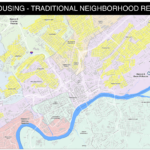Form-Based Coding is a revolutionary approach to zoning that has the power to inspire walkable neighborhoods, resilient communities, and thriving cities.
For over twenty years, our architects and urban designers have led the advancement of form-based code techniques and best practices. We have worked on over 60 Form-Based Codes (FBCs). In 2004, we co-founded the Form-Based Code Institute, a think tank that is now part of Smart Growth America. In 2008, we wrote what has been called the definitive book on FBCs. We are continuously evolving and advancing our application and best practices.
We know what makes a code effective. We established many of the graphic standards, system approaches, and usability components emulated today in many codes. So when you choose us, you can be confident that we’ll create a code that delivers results, implements your vision, and is easy to use.
Unmatched Depth of Knowledge and Experience with Form-Based Codes
Our coding experience began with small planning areas, including neighborhoods and downtowns, and evolved to include citywide corridor networks, citywide land development code updates, multi-jurisdictional countywide codes, and form-based bridges between FBCs and comprehensive/general plans. Because of that depth of expertise, we were asked to write the first development code for a rapidly growing city in West Africa. We have a clear track record to effectively tackle your coding project whether it’s small or large.
We are most proud that these codes are delivering results and helping communities. These codes have also been recognized with over a dozen local and national awards, including the Congress for New Urbanism Charter Award Grand Prize, multiple Driehaus Form-Based Code Awards, and two National APA Burnham Awards.
Objective Design Standards to Deliver Missing Middle Housing and Housing Choices
Not all Form-Based Codes have Building Types Standards, but they are at the core of most of our codes. We believe building types are the building blocks of great walkable urban places. This is partly because because they introduce (or re-introduce) a broader range of housing types into local development, and also because they help ensure high-quality built results.
Many building types, including Missing Middle Housing, cannot be effectively regulated by conventional zoning. These building types often have medium or high densities, which excludes them from single-family use zones, even though they are house-scale. Meanwhile, their small footprints and lower heights don’t fit the parameters or intent of existing multifamily and medium-density zones. So we’ve developed an effective way to regulate for them by including building type standards within our Form-Based Codes.
More Than a Great Code: Education, Buy In, and Built Results
To be effective, a coding project involves more than just writing the code itself. So we’ll first help you to lay the groundwork for your FBC, train your staff, review your procedures, and strategize how to completely update your code or make targeted fixes to establish objective design standards.
We’ll coordinate a multi-disciplinary team to effectively tackle challenges such as parking and street design, and engage and inform community perceptions around challenging topics including density. In the end, we’ll translate all of these elements into a high-quality built environment that your community wants.
Want help with your citywide code approach?
Request a CallDiverse Applications of Form-Based Codes
How We Can Help You Implement Your Community's Vision:
- 1Write a Form-Based Code for a small planning area, one or more neighborhoods, corridors, TOD, Priority Development Area, or your downtown.
- 2Write a Form-Based Code for your small town, entire city or county through a zoning update or an entire Land Development Code.
- 3Write a Form-Based Code to implement SB 2 (Housing and Jobs Act) and SB 35 (Affordable Housing and Streamlined Process) through objective standards.
- 4Assess/Diagnose your zoning code through graphic testing of existing standards and likely build out.
- 5Create a Form-Based bridge to your Comprehensive/General Plan.
- 6Advise on your FBC strategy to enable Missing Middle Housing.
- 7Craft targeted zoning fixes with objective standards to deliver housing choices and walkable living.
- 8Create supplemental architectural design guidelines to ensure quality implementation of the FBC.
Want Some Help?
Opticos Design respects the GDPR and will never share your information without consent. Read our privacy policy for more on how we handle your personal information.
"Opticos was an invaluable partner in helping Cincinnati achieve its goal of ‘Thriving Re-Urbanization.’ Their Form-Based Code was remarkably easy to use and has spurred confidence within the development community. Thanks to Opticos, the focus neighborhoods are seeing private sector investment that has not been seen in over 40 years.”
— Roxanne Qualls, Former Mayor, Cincinnati, Ohio

CNU32 Cincinnati Recap: Envisioning and Implementing Change Through Place Types
Tony Perez, Senior Associate at Opticos Design, led a Place Types exercise at CNU32 Cincinnati on May 15, 2024. The exercise followed presentations and discussion about best practices for using Place Types, led by Peter Park and Lisa Wise.

MMH Scan™ Supports Adoption of Middle Housing Standards in Knoxville
The Knoxville City Council recently adopted Middle Housing Zoning standards informed by Opticos’ Missing Middle Housing Scan. The Council’s aim is to expand housing options while preserving neighborhood character. Developed in collaboration with community input and Opticos Design’s consultation, these standards aim to facilitate the construction of diverse house-scale housing types within Traditional Neighborhood Residential zones.

Objective Design and Development Standards: More Housing, Great Places
Objective Design and Development Standards (ODDS) have been getting a lot of attention lately as laws are passed across the country seeking to streamline new housing developments. Requirements by states to include ODDS in local zoning codes mean big changes to the way many communities currently regulate and review development.






